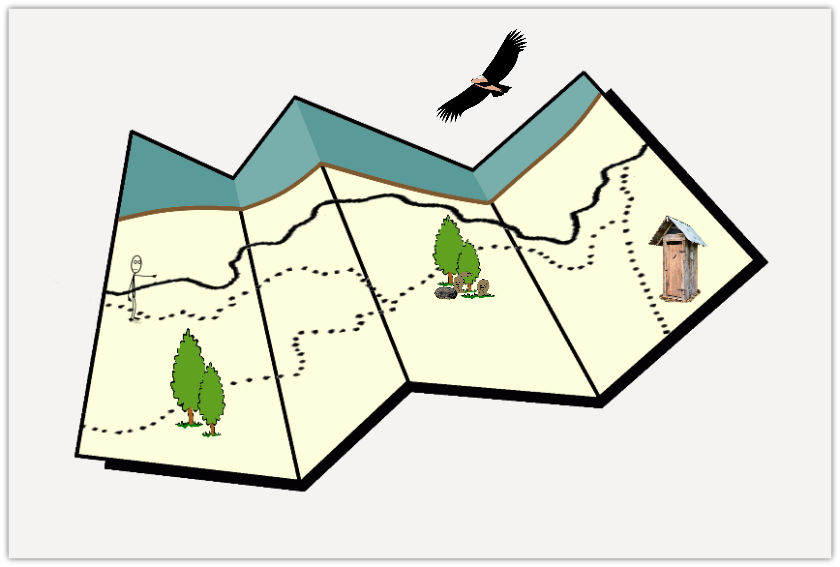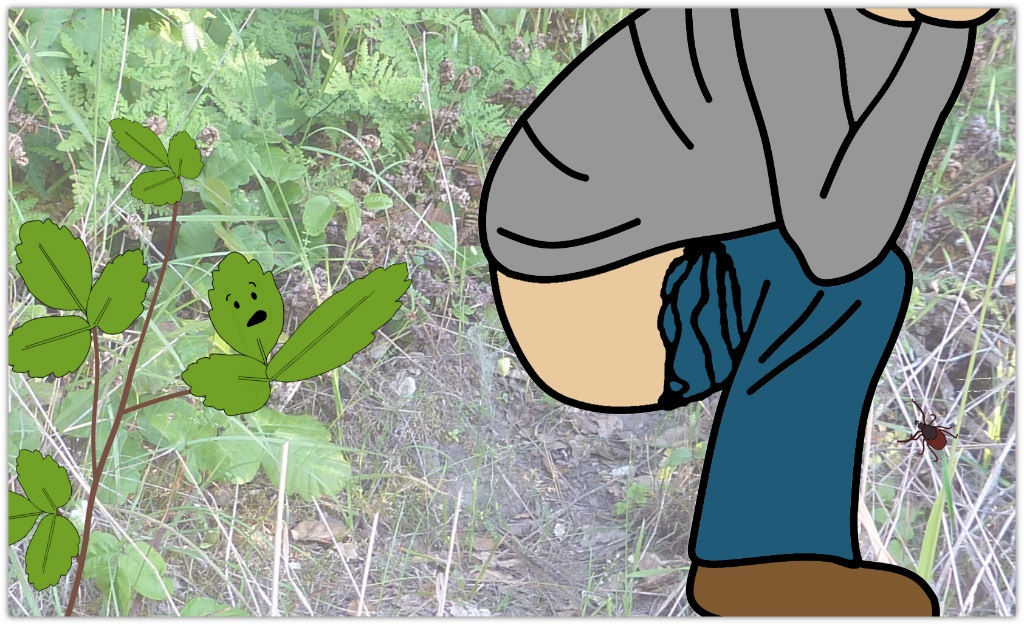When Nature Calls: Advice for Runners Who Doo-Doo It in the Woods
Dear A & H…Today’s topic centers around poop and pee, about how nature’s call could, quite literally, be hazardous to health and “home.” Thankfully, it’s not too difficult minimizing risk when runners find themselves “needing to go” and modern facilities are nowhere to be found. ت
When Nature Calls: A Little Perspective
For those of us who find running in and exploring wild places an ideal way to spend time, would it be generalizing too much to say that we, as a collective group, also have a keen interest in health?
Both, when approached sensibly, support and contribute to the success of the other. In essence, the pursuit of health is aided by running in wild places and, likewise, nature’s calm contributes to health of body and mind.
Truly, in our lifetime, we’ll likely never fully understand how movement and choosing to do so where civilization is barely existent can impact us so profoundly.
How does one even go about measuring that?
No matter, what’s important is all of us doing our darnedest to preserve these priceless places.
To this end, setting embarrassment and modesty aside for a moment, let’s talk about poop…and pee…and how to doo-doo it safely in the great outdoors to best protect:
- human health
- the wild places that bring unquantifiable peace of body and mind, and
- all the furry, feathery, and scaly “people” who call these beautiful spaces home.
Taking Care of You When Nature Calls
When airlines conduct safety drills at the beginning of a flight, they instruct parents to place their air masks on first before attending to their children. Of course, we know this is founded on the idea that if a parent keeps themselves in good working order, they can be of greatest assistance to their children, a preemptive and wise action that hopefully leads to the best possible outcome if conditions become less than ideal.
For the trail runner, such an approach is similarly sensible for those times when you find yourself miles away from the nearest restroom.
In such a situation, it’s reassuring knowing a plan is in place for best responding to bowel and bladder signals versus madly rushing off like you’re on fire, all because you misjudged “load capacity” and sphincter power. The latter happens, yet, to keep these situations down to a minimum, plan on scouting out a safe place to do your business at the first telltale signs of having to go.
And, when I say safe, I’m not talking about privacy.
What I am referring to is choosing a place that hopefully prevents your exposure to common trail hazards, two of these being skin-irritating plants (poison ivy, poison oak, and poison sumac) and disease-carrying insects (ticks).
Unfortunately, when in a hurry, we often forget about these.
I know I have.
One winter, in haste, I failed to notice the bare shrubbery branches surrounding my chosen spot. My hiney, to this day, has never let me forget that detour. In spite of poison oak’s nakedness during this time of year, it’s still very unfriendly to skin. 😢
Leaves of three, let it be
If it’s hairy, it’s a berry
If it’s shiny, watch your hiney.
And, in winter, though devoid of leaves or shine, it’s still a pain…on the butt.
Besides plant hazards, there are ticks to keep an eye out for.
When off-trail, consider any patch of shrubbery, tall grass, or leaf pile a potential tick hang out.
With this in mind, once you’ve done your business, check for ticks before setting off on your way. Those few seconds spent inspecting ankles, legs and anywhere you might have brushed up against plants could, quite literally, save you from a life-altering disease.
If, at this point, you’re a little spooked, don’t be. It’s important to be cautious and careful but not to the point where worry keeps you from enjoying yourself outdoors.
The following information, obtained from Huffington Post’s article “Lyme Disease Myths: 9 Things You Should Know About The Tick-Borne Disease”, should help dispel any lingering fear:
There are a number of types of ticks, but only blacklegged ticks (commonly called deer ticks) carry the bacterium that causes Lyme disease, according to the Centers for Disease Control and Prevention (CDC). Lone star ticks, the American dog tick, the Rocky Mountain wood tick and the brown dog tick do not transmit the disease. …not all deer ticks are infected with the Lyme disease bacterium. “In areas where [Lyme disease] is very common, one out of every four or five ticks might be infected,” says Paul Mead, M.D., MPH, chief of epidemiology and surveillance activity at the CDC. “In other areas where it’s much rarer, that may be more like one in 100.” Second, if a tick is removed within 24 hours of biting, risk of infection drops dramatically. “It’s important to take a definitive step quickly,” says Mead. “If you look for ticks every day and — [if you] find them — remove them, you aren’t likely to get Lyme disease.”
Of course, these aren’t the only hazards you might meet off-trail. The world is a big place with many things that itch, bite, and cause illness. That said, whenever you find yourself running in a new location, take a few moments to familiarize yourself with that area’s unique outdoor hazards.
Our Role as Environmental Stewards Especially When Nature Calls
As was mentioned previously, when the first signs of having to go make themselves known to you, it’s a signal to begin eyeing potential spots to safely do your business.
All places are fair game except…please, please, please…always remember…not near water.
It’s common knowledge that feces is laden with bacteria. It’s one reason the use of human manure has to be done with care.
Urine, on the other hand, is safer, it being sterile and all…
Or is it?
Hmm…
Actually, though we once believed it to be so, urine is not sterile. It also contains bacteria.
Understanding this, when the call of nature comes near an ocean, lake, pond, river, stream, brook, or reservoir, it’s recommended we take our business at least 200 feet (~60 meters) away from these water sources.
To help visualize what such a distance looks like, picture the long side of…
- three 25 yard swimming pools (or an Olympic swimming pool + 10 meters)
- approximately half a football field,
- two basketball courts, or
- three tennis courts.
By choosing your spot wisely this way, as well as burying poo and pee (please pack out wipes), we help prevent the spread of disease, especially to wildlife that relies on these sources for the raw water they provide.
Humans are fortunate in that we can treat our water before consumption, wildlife cannot. They use what’s available no matter the condition or risk.
So, for all the joy wild places bring us, let’s do our part in keeping these places safe and as pristine as possible.
Rubesco (rabbit): W-w-who?
Marv (vulture): Human
R: N-n-nooo?!
M: Yes.
R: Nooo!
M: Yes.
R: *wimper*…but, but, why does theirs sit around so long?
M: Food preservatives, I think.
R: Oh…
That’s It For Now
Thanks for reading…
❤
…and keeping these few tips in mind when nature calls.
When we mindfully make decisions and act kindly while passing through our favorite wild places, we preserve them for tomorrow’s use.
For more information on the actual “How To’s” for pooping outdoors, here’s a WikiHow article about just that. As with most things in life, there’s definitely a “best practice” for performing even the most basic of human needs.
Also, here’s an interesting bit of trivia about the decomposition of poop (courtesy of BackPacker.com):
Question: How long does it take for human feces in a cathole to break down into soil? Submitted by – Donald, Garland, TX
Answer: Short answer: a long, long time. Just like a compost heap, when you have moisture and warmth, the process takes less time. Out there in the wilds, you have a great variety of moisture levels and temps. Here in Wyoming, where I am, there are low levels of moisture and long winters, so fecal matter can be dug up years later—with lots of nasty pathogens still active. It would be a different story in, say, the swampy land of South Carolina. In the end, it becomes of great importance where we place our excreta. Dig down 6 to 8 inches at least 200 feet from a water source—and hide the spot well. —Buck
Much love, O.M.
P.S. Have you found this post helpful? If “Yes!,” please consider sharing, loving your body with a few miles today, and signing up for notice of new content. Thank you!
P.P.S. No spam ever. Staying away from processed is a healthy thing to do. 🙂





